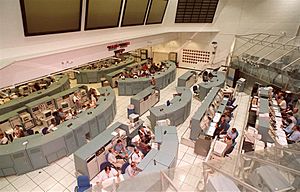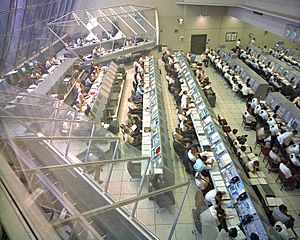Launch Control Center facts for kids
Quick facts for kids |
|
|
Launch Control Center
|
|

LC-39 Launch Control Center
|
|
| Nearest city | Titusville, Florida |
|---|---|
| Area | 12,047 m2 |
| Built | 1967 |
| MPS | John F. Kennedy Space Center MPS |
| NRHP reference No. | 99001645 |
| Added to NRHP | January 21, 2000 |
The Launch Control Center (LCC) is a special four-story building at NASA's Kennedy Space Center in Florida. It's where experts manage and oversee the exciting launches of rockets and spacecraft from Kennedy Space Center Launch Complex 39.
The LCC is right next to the huge Vehicle Assembly Building. Inside, it has offices, special equipment for tracking rockets, and important "firing rooms." These rooms are where the launch teams work.
The LCC has been used for many historic launches. The very first one was the unmanned Apollo 4 mission on November 9, 1967. The first time humans launched from the LCC was with Apollo 8 on December 21, 1968. This building was also key for all the Space Shuttle missions. Today, NASA has updated the LCC for future missions, like the powerful Space Launch System (SLS) rockets, which started with Artemis 1.
Contents
Inside the Launch Control Center: Firing Rooms

Launch operations are carefully watched and controlled from several special rooms called "firing rooms." In these rooms, controllers check everything before a launch. They make sure the rocket and spacecraft are ready to go.
Once the rocket lifts off and clears the launch tower (usually in the first 10 to 15 seconds), control is then handed over. The mission is then managed by the Mission Control Center at the Johnson Space Center.
One of the firing rooms, Control Room 4, was completely updated in 2006. Today, SpaceX uses Firing Room 4 as their main launch control center.
Meet the Launch Team: Key Roles
Many different people work together to make a rocket launch happen. Here are some of the most important roles:
The Launch Director (LD)
The Launch Director is like the captain of the launch team. They are in charge of everything. After checking with all the other team members, the Launch Director makes the final "go" or "no go" decision for the launch. From 1981 to 2011, there were eight different Launch Directors for the Space Shuttle program.
The Flow Director (FD)
The Flow Director makes sure the spacecraft is ready for launch. They stay in the LCC to offer advice and help.
The NASA Test Director (NTD)
The NASA Test Director is responsible for all the tests done before a launch. This includes tests involving the astronauts, the orbiter, the rocket boosters, and all the ground equipment. The NTD also makes sure everyone on the launch pad is safe after the rocket has been fueled. They report directly to the Launch Director.
The Orbiter Test Conductor (OTC)
The Orbiter Test Conductor leads all the checks and tests for the orbiter (the part of the spacecraft that goes into space). They manage the engineers in the firing room who watch the orbiter's systems. The OTC usually works for a contractor company, not NASA directly.
The Payload Test Conductor (PTC)
The Payload Test Conductor is in charge of testing the "payloads." Payloads are the satellites or other items that the rocket carries into space. They manage the teams that monitor and control these payloads on the ground. The PTC is also a contractor member of the Space Shuttle Team.
The LPS Coordinator (LPS)
The LPS Coordinator watches over the Launch Processing System (LPS). This is a smart computer system that helps manage the entire checkout and launch process. The coordinator makes sure the launch is on schedule and that all safety rules are followed.
The Superintendent of Range Operations (SRO)
The Superintendent of Range Operations makes sure all tracking and communication systems are ready for the launch. They also check that the airspace and ocean areas where rocket parts might fall are clear. Plus, they monitor the weather near the launch site.
The Ground Launch Sequencer Engineer (CGLS)
This engineer watches the automated Ground Launch Sequencer system. This system controls the countdown from T-9 minutes (9 minutes before launch) until the rocket lifts off. If needed, they can manually stop the countdown before T-31 seconds. After T-31 seconds, only an automatic stop is possible. If the countdown stops automatically, it usually means the launch will be delayed for at least 24 hours.
Images for kids







